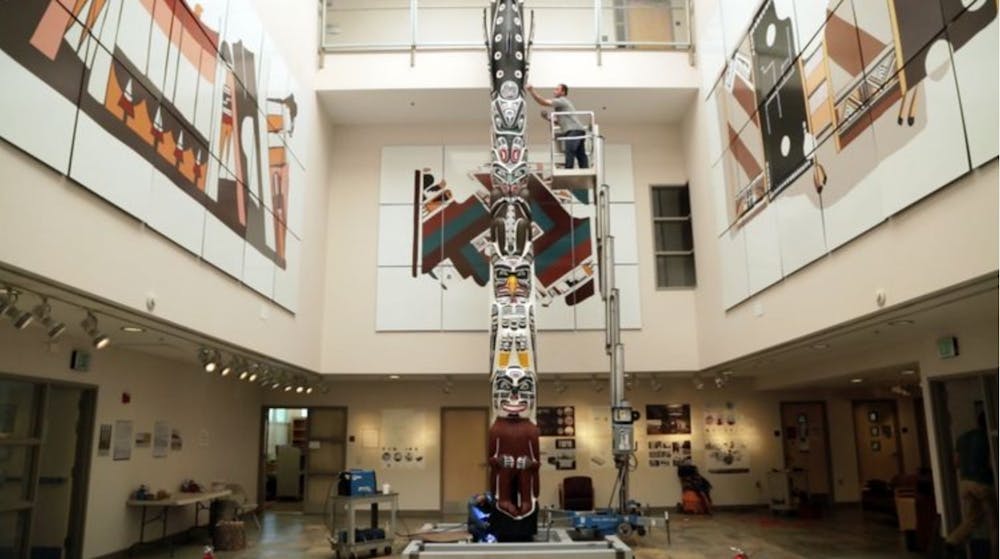The Smith Family Totem Pole, located at the Hibben Center on the University of New Mexico campus, has not always been represented or respected as the sacred item that it is.
In 1941, then-assistant anthropology professor Frank Hibben took the pole from the Smith family of the Tlowitsis Nation in British Columbia, but said that he had bought it for two cases of whiskey, according to the UNM Department of Anthropology.
Hibben took the pole after he was told he could not have it, according to Lea McChesney, curator of ethnology at the Maxwell Museum of Anthropology.
“We know that the pole was taken illicitly,” McChesney said.
Hibben misidentified the pole as Tlingit, from Alaska. Because of this, the pole was able to bypass security at the United States-Canada border, according to anthropology professor Les Field.
The legal documents that showed that Hibben could transport the pole were for a different one, McChesney said. At that time, no Canadian Indigenous items could be sold or bought, she said.
Chief Smith Sewid – or Sewidanaquilla – commissioned the pole from carver Charlie Yakuglas James in 1907 on Turnour Island, British Columbia, Field said.
The Smith family reported the pole missing to the Canadian Mounties as a theft when they returned to the nation from a fishing trip, according to the UNM anthropology department. McChesney believes that Hibben would have known about the trip and taken advantage of their absence, she said.
“In the case of the totem pole, the acquisition of it was so reprehensible. It really is a purloined possession of the Tlowitsis people that was taken from them in a completely illegitimate way,” Field said.
When the pole first arrived at UNM, it stood in front of Scholes Hall. In 1973, it was moved to the Maxwell Museum of Anthropology’s courtyard, according to the UNM anthropology department.
“I came to UNM in 1994 and I saw the totem pole out in the courtyard of the Maxwell Museum — no plaque, no information,” Field said.
In 2015, a student in a class on Native American art taught by Beverly Singer reached out to Field to gain the anthropology department’s support to research the pole, Field said.
Get content from The Daily Lobo delivered to your inbox
Field had heard “off-color, nasty stories about how Frank Hibben and his buddies used to take potshots at it,” and personally wondered about the pole’s origins, he said.
The research led to a relationship with the Smith family – the pole’s rightful owners – in 2016, which then led to a discussion about what to do with the pole, Field said.
Representatives of the Tlowitsis Nation and representatives of the Maxwell Museum reached an agreement after discussing and piecing together the pole’s true history, McChesney said. This agreement can be altered by either party.
The Maxwell Museum developed a plan to relocate the pole into the Hibben Center, just south of the museum, according to McChesney.
“It would be restored by carvers of the Nation’s choice,” McChesney said. “We also agreed that we would recognize that the pole did belong to the Tlowitsis Nation and we would serve as stewards of it.”
Other factors went into moving the pole from the location in the courtyard, according to McChesney.
“The concern then was, because of its condition, it might represent a potential danger to visitors,” McChesney said. “It was very much exposed to different elements here than there would be in the climate where those poles are typically raised.”
A team, led in 2017 by Kwakwaka'wakw artist and lead carver Tom Hunt Jr. with his apprentice Bertram Smith, restored the pole and placed it in the Hibben Center atrium, according to the UNM anthropology department. The team received permission to include turquoise in the color scheme to honor the Indigenous people of New Mexico, McChesney said.
Then Department Chair Field and then Maxwell Museum Interim Director David Phillips Jr. wrote and signed an apology letter to then-Tlowitsis Nation Chief Danial Smith in 2017. The letter includes a brief history of the pole at UNM, as well as goals to address the damages done to the pole.
Funding for the pole’s restoration came from both the Alfonso Ortiz Center for Intercultural Studies and the Hibben Trust for Anthropological Research, McChesney said.
During the restoration, the Maxwell Museum team took lidar scans – which act as a form of penetrating photography – and three-dimensional photography of the pole. The team then gave copies to the Tlowitsis Nation, McChesney said. This information could help the same carvers create a new pole in front of a community house in the Tlowitsis Nation, she said.
McChesney’s organization is working on providing some of the funding for the new pole, she said.
The Smith Family Totem Pole can be viewed at the Maxwell Museum from 10 a.m. to 4 p.m. Tuesday through Saturday.
Marcela Johnson is a beat reporter for the Daily Lobo. She can be contacted at news@dailylobo.com or on Twitter @DailyLobo
Marcela Johnson is a senior reporter for the Daily Lobo, and the editor-in-chief of Limina: UNM Nonfiction Review.






